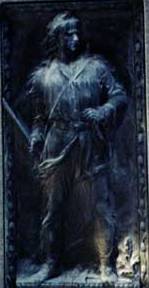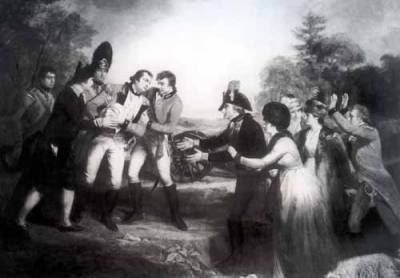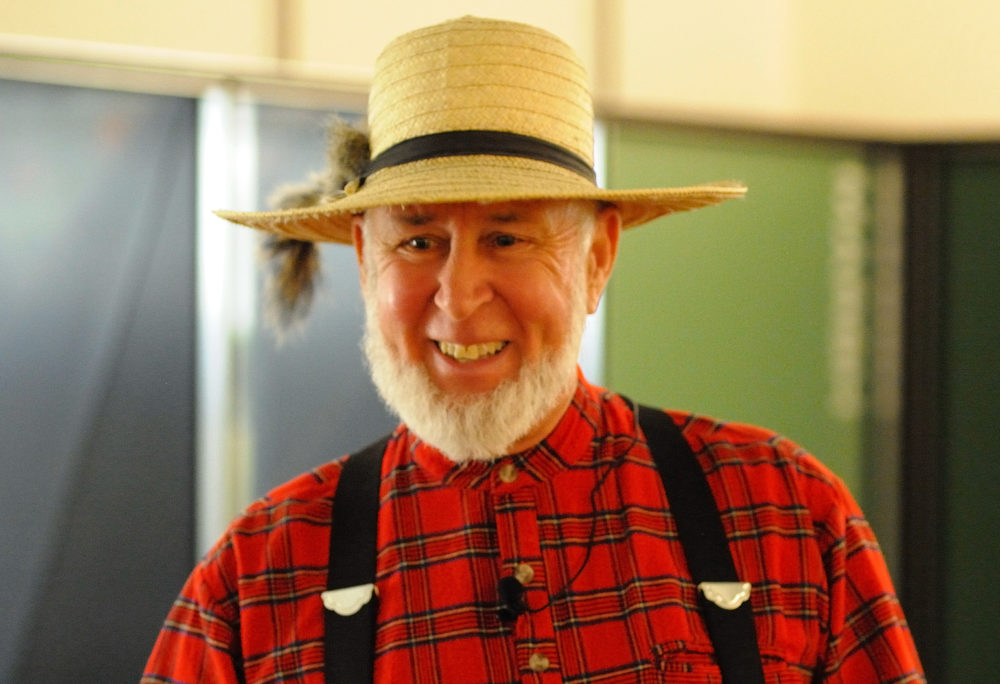
The Declaration of Independence, adopted in Philadelphia in 1776, was unquestionably a great step in the creation of our United States of America. But the joyous occasion of the Declaration was followed by years of at times desperate struggle. King George III and the Parliament of Great Britain did not bid their North American colonies pleasant well wishes. The rag-tag army under George Washington eventually learned to hold their own against the formidable “King’s Regulars”, until both King and Parliament grew tired of the effort. Students of the American Revolution know that the Battle of Saratoga in eastern New York was a turning point in that war. A turning point in the battle itself was the death of British General Simon Fraser, who time and again rallied his troops against the Continentals’ assaults. When Fraser fell, the resolve of his soldiers crumbled. Simon Fraser was felled at a distance only achievable by a Pennsylvania long rifle in the hands of an unusually gifted marksman. Such a man was Tim Murphy. If you visit the Saratoga battlefield today, you will find among the many monuments and markers a bronze tablet commemorating Murphy’s feat, and its significance to the outcome of the battle, as well as to the eventual creation of these United States. Tim Murphy was a Pennsylvanian.
So who was this man Tim Murphy? He was born William Baskins, on an island in the Susquehanna River, just below its juncture with the Juniata. The Baskins family, for whom the island was named, were on the edge of the Pennsylvania frontier. The year was 1756. William’s father had claimed the fertile island land, built a cabin to house his family, cleared land and planted as many crops as he could tend. But these were turbulent times on the frontier. The Native American Indians resisted any settlement beyond the eastern edge of the river. Many raids had taken great toll of those hearty souls who ventured to and west of the Susquehanna, so the Baskins, along with many other families from further west as well as farther north on the river, had fled downstream to the relative safety around the ferry site of John Harris.
But winter was coming on. Food, always scarce in the trying Pennsylvania winter, would be even more so with all the families crowded into Harris’s small fort. Mr. Baskins knew that not far upstream his corn was ripened. Although it was too dangerous to return to his homestead to live, he had to go back and try to harvest that corn. One mild day in early fall, Baskins, with his wife, two small children, and a hired hand traveled back up the river, towing a flat bottomed boat, no easy task against the southward current of the Susquehanna. With luck, they could fill the boat with ripened ears of corn and be back downstream to safety by days end.
The plan was a good one. What the Baskins didn’t know was that closing in on their island homestead from the north was a scouting party of Iroquois warriors. From previous trips by the area, they also knew the corn crop was ripe for picking. Corn made up a significant part of the winter diet of the eastern Indians. Iroquois villages were surrounded by acres of orchards and cornfields, but this extra crop, free for the taking, was too good to pass up. The Baskins party arrived at the island first, and were quickly hard at work picking the ripened corn. All too soon they were surprised by the Indians. At the first war whoop, William Baskins ran for his nearby rifle, but a shot from an Iroquois rifle felled him dead. The hired man took off for the river and escaped to the eastern shore. Mrs. Baskins and the two children were not so fortunate. They were taken as captives by the Indians, and made to continue harvesting the corn, but this time it went into the Indians canoes instead of the Baskins’s boat.
By late afternoon, the Indians with their corn and their captives were headed back upstream. Historical records tell us that Mrs. Baskins somehow managed to escape and made her way back to the fortification at Harris’s Ferry to which her family had fled earlier. Her children, Peggy, aged seven, and young William, aged three, were kept by the raiding party. Peggy would be sent west to the Ohio country where she lived among the Miami tribe. Her destiny is unknown, although she may have been one of the many captives who were returned after Colonel Henry Bouquet’s triumphs over the western tribes in 1764. Young William remained for awhile among the Iroquois in New York. As the Iroquois were officially at peace with the English colonists, it was decided to send William west as well. He was sold or traded to the Huron, in the area that today is Michigan, a not uncommon practice among the tribes. There William was given the name “Tear”, for the unique tear-drop shaped birthmark below his eye. As did most young captives, Tear took easily to the indian way of life. He was treated well, adopted as a family member, and taught all the skills and crafts of the budding Huron warrior.
It was at this point that Tear’s fate took an unusual twist. Sir William Johnson was an English gentleman who had the unenviable job of trying to keep peace between the ever western-spreading colonists and the numerous tribes of native-Americans. There was often hostility between the tribes as well, some of it dating back generations. The Huron tribe was often belligerant, and Sir William , when he met the young boy named Tear, thought he could help create friendlier relations. Thus young Tear was brought under the tutelage of Sir William. From excellent tutors, he would learn to speak the King’s English. This skill, at a time when many on the frontier were largely illiterate, would serve him well all of his life. Sir William also thought that the boy needed an English name. No one at that time knew he had started life as William Baskins, and so Sir William Johnson picked the name Timothy Murphy. It sounded right for a young man of obvious Scots-Irish descent. It was years later before his birth-name was determined. By then the young man thought of himself as Tim Murphy, and saw no reason to resume being William Baskins.
Soon thereafter, two events occurred that turned this young man’s life yet again. The first was the death of Sir William Johnson, his benefactor. Tear resumed his life with the Huron, but this too was not to last. Following victories over the western tribes by Colonel Henry Bouquet in the 1760s, the tribes were ordered to return all of the captive whites living amongst them. Once again calling himself Timothy Murphy, and knowing nothing of his former family or from where he had been taken into captivity many years before, he returned to the life of the frontier settler. He was young, still a teenager, but old enough to set out on his own.
The story forwards to the days of the American Revolution. Many of the soldiers who served the patriot cause throughout the war were Scots-Irishmen from the western frontiers of the colonies. Oh yes, love of freedom and patriotism were a large part, but as much a part of the decision of these men to join the army was a hatred of England that had been inbred for generations. Then too, a Scots-Irishman just loves a good fight, wherever he finds it. So it is not surprising that Tim Murphy found himself with the Northern army. Tim’s command of the English language, along with a fluency in Huron and the languages of some other tribes as well, was known and valued by his officers. But Tim had another skill that was exceptional, and that was his marksmanship with the longrifle. These weapons, brought to the new world by the Germans, but modified in length and detail by the gunsmiths of southern Pennsylvania, were, in the hands of even a modest marksman, accurate beyond belief. Shooting game and targets at two hundred yards was almost expected. But Tim Murphy had a most unusual combination of hawk-like eyesight and immutable concentration. Murphy could consistently hit targets at four or five hundred yards, distances at which many shooters could not even see the mark.
Tim spent time with several military units. In time he would come to serve with the famed rifle battalions of the even more famous Colonel Daniel Morgan. Morgan had brought his unit of Virginians to join the war effort during the seige of Boston in 1775. He and his men had gone with Benedict Arnold on the treacherous winter journey to try and capture Quebec. Now Arnold and Morgan were along the Hudson River of up-state New York, and the advancing British army of John Burgoyne was coming south out of Canada. Wars take their toll. Morgan needed riflemen. Tim Murphy was beginning to make a name for himself as a marksmen. It was claimed by those who should know that Murphy had shot British soldiers and officers at great distances. Dan Morgan came to know of his skills.
The Continental forces were holding their own, and giving evidence of winning the day, but the stubborn defense by British 24th Regiment, along with Riedesel’s Hessian forces, under the command of General Simon Fraser was frustrating Benedict Arnold’s advance. Fraser, on his gray horse was constantly back and forth along his lines, urging his men to hold their ground. Arnold directed Morgan to do all in his power to remove Fraser from the action. “That gallant officer is General Fraser. I admire him, but it is necessary that he should die,” is the most memorable quote attributed to Arnold. Morgan in turn called on Tim Murphy. Tim cleaned and loaded his rifle, climbed a tree, found a solid perch, and shot his way into history. Tim’s first shot cut a piece of the bridle of Fraser’s horse; his second shot creased the horse’s mane. Loading his double-barreled rifle one more time, Tim shot yet again, this time hitting Fraser in the chest. Fraser was at least five hundred yards away. Even Morgan, a legendary rifleman himself, had doubted that the shot could be made as such a distance.
Fraser was carried from the field, and would die the next day, but his fall took the resolve out of the British line, and they soon retreated from the fray. Historians tell us that this in turn contributed much to Arnold’s overall victory over Burgoyne’s army. A Pennsylvania long rifle in the hands of a skilled Pennsylvania-born marksman made a huge impact on the fate of the American colonies.
The New York State Legislature voted to erect a monument to Murphy in 1819, the year following his death, but nothing was done until 1910 when some of his descendants purchased one to be placed in the cemetery where he lies. The picture at the beginning of this story is of the bronze likeness of Murphy on his grave. In 1913, the Ancient Order of Hibernians placed a marker commemorating Murphy on the Battlefield, and the state put up its own marker there in 1929. The following is from the 1929 dedication address of the state monument by then New York Governor Franklin Delano Roosevelt. “This country has been made by Timothy Murphys, the men in the ranks. Conditions here called for the qualities of the heart and head that Tim Murphy had in abundance. Our histories should tell us more of the men in the ranks, for it was to them, more than to the generals, that we were indebted for our military victories.”
A bronze plaque on the New York grave of Murphy states, “Tim Murphy – Patriot, Soldier, Scout, Citizen who served distinguishably in Morgan’s Rifle Corps, fought at Saratoga and Monmouth and whose bravery repelled the attack of the British and their Indian allies from Middlefort, October 17, 1780 and saved the lives of the colonists of his Schoharie Valley. Here too, this warrior sire, with honor rests who braved in freedom’s cause his valiant breast.”
Some 210 years after he died, a plaque in Fraser’s honor was installed on the Saratoga battlefield. The exact site of his burial is disputed. This plaque is placed about two miles west of the area of his death, on the lawn of the Saratoga National Historical Park’s visitor center, overlooking the Battlefield.
The picture at the top of this page shows a portion of his Murphy’s monument at Saratoga. The picture below is of the death of General Fraser.

There are several versions of the life of Tim Murphy. In truth there has been great debate among historians as to whether or not he is truly the man who shot Simon Fraser. Although the act was not attributed to him until some 60 years afterwards, it is important to note that no other name has ever been associated with the deed. The account offered here owes much to the writings of Perry County historical novelist Roy Chandler. Baskin’s Island is in Perry County Pennsylvania.
